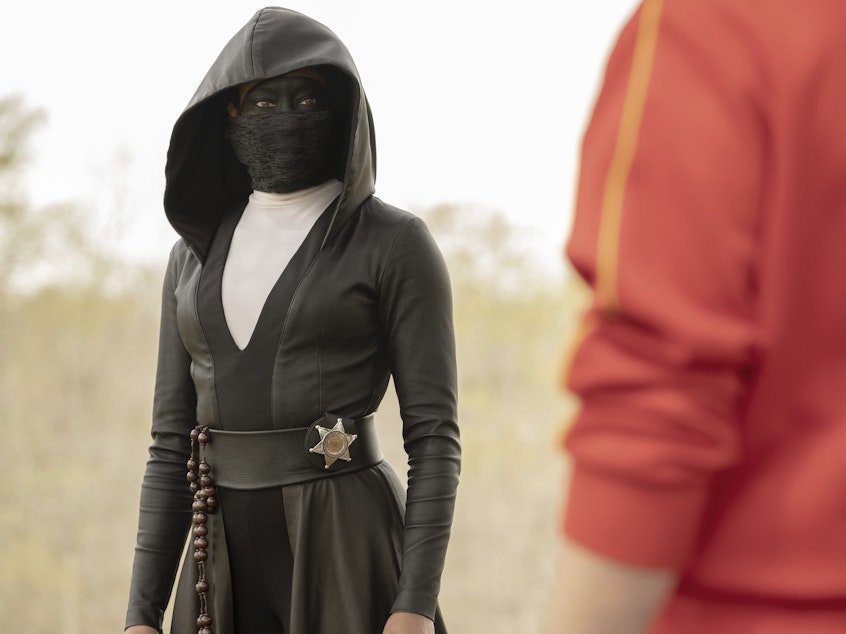Who Watches This 'Watchmen?' I Will, And You Should

The classic graphic novel Watchmen – an explicit, realistic take on what the world might be like if people actually put on costumes and masks to fight crime — tackled many social and political issues: American imperialism. Nuclear tensions with the Soviet Union. The corruption of a President Nixon who stayed in office for five terms.
But there's one subject the book — hailed by Time magazine as one of the 100 best English-language novels of the last century – didn't really approach.
Race.
So it makes a certain kind of sense that, when superstar TV producer Damon Lindelof (Lost, The Leftovers) decided to build an HBO series around a modern continuation of the 1980s-era novel – okay, comic book — racial tension would be the first thing he tackled.
The result is a visually stunning, energetically complex series that digs into the hottest social issue of our time. But it's done in a way that may leave viewers unsure exactly what Lindelof is saying about it all.
Sponsored
HBO's Watchmen opens with a bloody scene: Race riots in Tulsa, Oklahoma in 1921, when mobs of white people attacked black people and businesses in the city's Greenwood district, killing hundreds and arresting thousands.
Flash forward to Watchmen's 2019: The actor and liberal/environmental icon Robert Redford has been president since 1992. Cars are electric, tobacco is a controlled substance and some black Americans have received reparations payments from the government, derisively called "Redford-ations" by aggrieved white folks.
Some of those aggrieved white people formed a group of violent white supremacists called the 7th Kavalry, wearing the mask of a former superhero called Rorschach, to target police and people of color. Because the Kavalry succeeded in attacking Tulsa police at their homes in a murderous strike called the White Night, cops are now allowed to wear masks.
All of this, by the way, is just the setup – the framework to understand Lindelof's tale. The storyline of the comic book is canonical history for the TV series, and as a longtime Watchmen fan, I can't imagine trying to decode HBO's program without knowing the source material (Be advised: the TV show's story isn't connected to the 2009 Watchmen film, which had a different ending).
My favorite callback to the Watchmen comic is a character played by the always-excellent Jean Smart: a cynical, heroically-damaged middle-aged version of Laurie Juspecyk. She fought crime in the 1980s as the superhero Silk Spectre, but in 2019, she's become an FBI agent named Laurie Blake who hunts down costumed heroes, now outlawed. Blake comes to Tulsa to investigate the death of a police officer, swaggering through scenes with a world-weary confidence that makes her a singular character.
Sponsored
It's not obvious, even after watching the first six episodes provided to critics, why Lindelof chose to center so much of this new Watchmen story on race. If he's making some larger point beyond the obvious depictions of racial resentment, the resilience of racism or liberals' ham-handed solutions, it escaped me.
But that choice does allow for many cool moments. Noted African American scholar Henry Louis Gates, Jr. pops up as the Secretary of the Treasury (What better man to put in charge of "Redford-ations?"). The history of an enigmatic superhero from the graphic novel, Hooded Justice, is revealed in a compelling, expertly-told tale that involves segregation, closeted gay men, racism in policing and mind control. (I know! It's a lot. But so very good!)
And Regina King kicks all kinds of behind as Sister Night, a masked police officer who maintains a cover identity as Angela Abar, a retired cop-turned-baker. It's particularly awesome that – in another change from the comic – several compelling characters with agency in HBO's Watchmen are female, including King's Abar, Smart's Laurie Blake and an enigmatic trillionaire named Lady Trieu.
There are other recognizable names: Don Johnson plays Tulsa's police chief; Lou Gossett Jr. is a grown-up survivor of the Tulsa massacre and Jeremy Irons is the hero-turned-villain of the Watchmen comic, super-intelligent Adrian Veidt, a.k.a. Ozymandias.
At times, it seems the show is trolling liberal sensibilities, showing a world where reparations and energy-efficient cars didn't add up to a much better society. And it is daunting to tackle a series where the narrative engine only seems to kick in at the fifth or sixth episode.
Sponsored
Still, as someone who bought every issue of Watchmen when it was first published as a series of comic books in 1986, I am hooked by this series. It meticulously builds a modernized version of the world originated by Watchmen creators Alan Moore and Dave Gibbons, taking its time to roll out a story that subverts the original comic book nearly as much as it references it.
The original Watchmen turned on the idea that, in a realistic world, vigilantes who pull on masks and costumes to fight crime wouldn't necessarily be heroes – but they would definitely be deeply psychotic.
HBO's new Watchmen presents a reality where the only heroes left are masked police officers, hunted in ways people of color once were – and, sometimes, still are.
Lindelof's work will either add up to the coolest, most intricate dramatic series this side of Westworld or the biggest swing-and-a-miss in recent television history.
Either way, this Watchmen fan will definitely be paying attention. [Copyright 2019 NPR]



